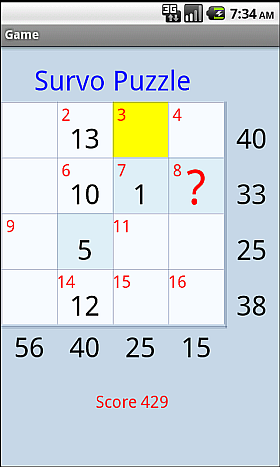Environment for creative processing of text and numerical data |  |
Survo puzzles can now be solved as a quick game on Android phones with a touch screen simply by tapping cells in the game board.

You can see from the display above a typical setting when a 4x4 Survo puzzle is being solved. This game is published on Android Market,
The task is to fill the 4x4 -table by numbers 1,2,...,16 as quickly as possible so that the row and column sums of the numbers are equal to values given on the borders of the table.
Always, at first, you have to select a cell in the table where to put the next number. By tapping that cell, a red question mark [?] will be displayed in it.
Then the number you want to put in that cell is picked by tapping a cell containing that number in red.
If you have selected a correct number, it will be placed in the [?] cell and the score (displayed in red below the table) grows.
If your choice is not correct, the score is decreased and an interval of two tones will be heard. The direction and size of this interval indicates the error. The error is also displayed as a simple numeric expression below the game board.
The score is also reduced by the time elapsed. So you have to be
quick and smart in your decisions.
If you get scores above 1000, you can send your best score (Record) with its 9-digit Check code to support@survo.fi
Also in this case 10 highest scores are listed.
If you get total scores above 3000, you can send your best total score with its 9-digit Check code to support@survo.fi
Send your best result in the 'Game of 3 rounds' with the 9-digit Check code to support@survo.fi
You are allowed to send new results if you attain still higher scores.
The winner is the person who has attained the highest total score in the 'Game of 3 rounds' and sent it with its Check code to support@survo.fi before the end of this year 2011.
The winner will get a prize of 500 euros. If several persons have attained and sent the same highest score, the earliest person is the winner.
The name of the winner will be announced on this web page on January 3, 2012.
The competition has been ended: The winnwr is Juha Valtonen with score 3184.
For this reason, the smallest and greatest numbers give small scores, but numbers in the middle range (as 8,9,7,10, etc.) give best scores. Therefore it is good to detect those middle range numbers in an early stage of the game, since also their values diminish towards the end of the game.
If positions of some "bad" numbers (as 1,16,2,15, etc.) are detected in an early stage, a good player does not select them readily but keeps them in memory and uses them only at the end of the game.
![Number 8 only alternative for [?]](spuz4small.png)
At a later part of the game a good solution often requires really quick mental arithmetic and reasoning. For example, in the situation above it is easy to see that numbers 1,2,4, and 8 will be in the second column.
The most valuable number 8 cannot be on the row 1 since in that case the last number on that row would be 34-11-8-5=10 which is not anymore available. For similar reasons 8 cannot be on the row 3 or 4. Thus 8 goes to the row 2 and the last number on that row will be 39-10-8-9=12 which happen to be the second best of the numbers available.
In most games, a few cells are painted light red or blue as here on the second row. The game program paints a cell light red when the true number coming to that cell is greater than expected and light blue when the true number is smaller than expected. A good player can take advantage of these colorings.
The color predictions are based on the fact that the products of row and column sums from smallest to greatest correspond rather well to positions of numbers from smallest to greatest. More about this topic on a page about the Swapping method.
For example, if you hear an ascending Third interval meaning that
the number you have just selected should be raised by 3, in this mode
+3: Major third up
is displayed below the game board.
The names of intervals correspond to the size of the error in a natural way so that Fourth=4, Fifth=5, Sixth=6, Seventh=7, and Octave=8. fourth=4, fifth=5, sixth=6, seventh=7, octave=8. The only exception is Minor second=1 (Major second=2).
Descending intervals indicate in the same way how much the selected number should be lowered.
General information about Survo puzzles